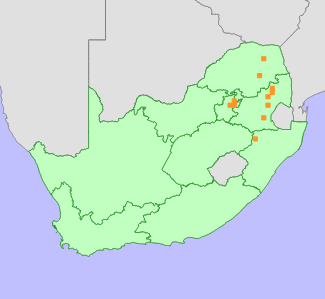Fish, L., Mashau, A.C., Moeaha, M.J. and Nembudani, M.T. 2015. Identification guide to southern African grasses. Strelitzia 36. South African National Biodiversity Institute, Pretoria.
Gibbs Russell, G.E., Watson, L., Koekemoer, M., Smook, L., Barker, N.P., Anderson, H.M. and Dallwitz, M.J. 1990. Grasses of southern Africa. Memoirs of the Botanical Survey of South Africa 58:1-437. Botanical Research Institute, Pretoria.
Hilton-Taylor, C. 1996. Red data list of southern African plants. Strelitzia 4. South African National Botanical Institute, Pretoria.
Kirkman, K.P. 2002. The influence of various types and frequencies of rest on the production and condition of sourveld grazed by sheep or cattle. 2. Vigour. African Journal of Range and Forage Science 19(2):93-105.
Launert, E. 1971. Gramineae. In: A. Fernandes, E. Launert and H. Wild (eds). Flora Zambesiaca 10 (Part 1):11-152. Flora Zambesiaca Managing Committee, London.
Pfab, M.F. and Victor, J.E. 2002. Threatened plants of Gauteng, South Africa. South African Journal of Botany 68:370-375.
Raimondo, D., von Staden, L., Foden, W., Victor, J.E., Helme, N.A., Turner, R.C., Kamundi, D.A. and Manyama, P.A. 2009. Red List of South African Plants. Strelitzia 25. South African National Biodiversity Institute, Pretoria.
|
 Comment on this assessment
Comment on this assessment


